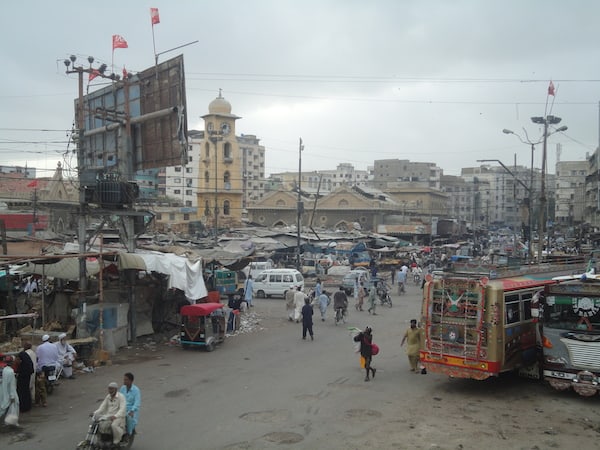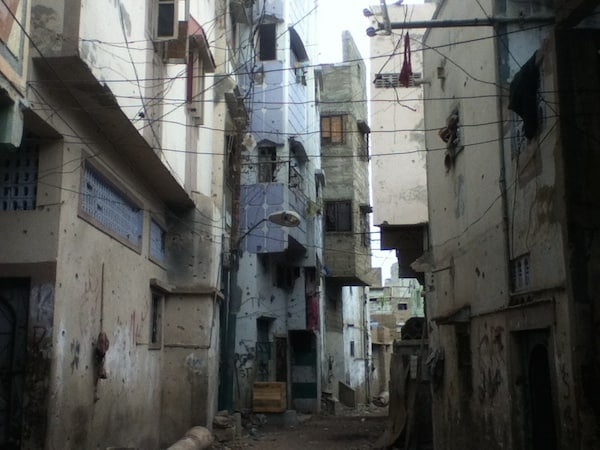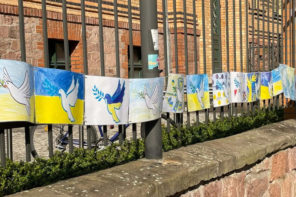I first visited Lyari in August 2012 when I joined Laurent Gayer in conducting a focus group discussion with members of a community-based organization, which worked on providing education to youth in the area. Until this visit I had only heard snippets about this part of the city in terms of its reputation for violence and criminality, but having not grown up in Karachi and having only done limited fieldwork in the city, I knew very little of substance about this supposed ‘no-go’ area. The members of the community organization, who were largely Baloch, talked about how Lyari had been maligned by the media, how people in Lyari were discriminated against in employment, how the state security forces targeted them, and how a certain political party had waged a campaign against them. These themes–marginalization, stigmatization, political manipulation and state neglect—were issues I had explored before in my previous work on Muslim marginalisation in Delhi (Kirmani 2013). However, the context was extremely different. Where religious identity was the main dividing factor in Delhi, ethnicity, which often overlapped with political affiliation, seemed to be the major cause of conflicts in Karachi. I continued to visit Lyari over the course of the following two years in order to understand the roots of the area’s marginalisation and conflicts, building relationships with many of the residents in the process.
Lyari is referred to by outsiders as ‘the Colombia of Karachi’ because of its perceived control by drug mafias. However, the residents of this area proudly refer to Lyari as ‘Karachi ki maan’ (the mother of Karachi) because it is one of the oldest settlements in the city.
Lyari began as a fishing settlement in the early eighteenth century and was one of the few majority-Muslim areas of Karachi before Partition. The population of the area grew significantly during the period of British colonial rule, when the British began modernising Karachi’s port, relying largely on labour from Lyari. Although Lyari is often characterized as a Baloch area, the Baloch comprise approximately half of Lyari’s population and the rest include Punjabis, Katchhis (originally from Gujarat), Sindhis, Pashtun, and some Muhajirs whose families migrated from what is now India in the years following Partition. This diversity is a source of pride for many of Lyari’s residents. Covering approximately 1800 acres of land in Karachi’s South district, Lyari is extremely densely populated, and as in most parts of the city, many of the area’s conflicts are related to the struggle for control of land by various powerful groups including state actors, political parties, criminal gangs, and various mafias, with the lines between all of these groups often blurring.
The name ‘Lyari’ itself has come to be synonymous in Karachi with violence, crime and gangs. Because of this, I have had countless arguments with my family and friends about why I repeatedly visit this most-feared part of the city. No amount of assurance that the areas I was visiting were safe or that I had good friends there who were taking care of me would put their minds at ease. This is not to argue, as many of the residents of Lyari often did, that Lyari was safe. However, the reactions I received were disproportionate to a much more complex reality, one in which violent events did occur with varying frequency but most of the time were targeted at particular individuals, groups or areas. Ironically, and to the chagrin of my friends and family, all of these reactions only fed my interest in Lyari more, not because I am stubborn or a thrill seeker, but because they reflected the deep ethnic and class divisions within Karachi itself. These divisions exist in the minds of all people living in Karachi, including my own, and they have continuously grown in the last decades as violence in the city has escalated.
These divisions are fueled by a fear—a fear that is all the more powerful because the perpetrators of violence are often unknown individuals, or as people in Karachi call them, namaloom afraad.
Even when the identities of perpetrators are known, they must by necessity remain nameless creating a kind of conspiracy of silence that further feeds the cycle of violence.
Fear has certainly become a ‘way of life’ (Green 1999) in Karachi. Laurent Gayer (2014), in his recent book, Karachi: Ordered Disorder and the Struggle for the City, describes fear as being experienced as a ‘chronic condition’ in the city. His work highlights the ways in which residents of Karachi have altered their everyday lives by developing ‘flexible routines’ in order to navigate around potential sites of violence (ibid.: 242). This ‘hermeneutics of danger’, where residents must constantly read physical and atmospheric signs in order to avoid danger, leads people to live in a state of constant insecurity (ibid.). As Gayer so eloquently argues, fear and insecurity structure the everyday spatial tactics of Karachi’s residents in profound ways. For those living in contested spaces including in ‘no-go areas’ such as Lyari, people must restrict their movements to particular routes, limiting their exposure to public spaces both within and outside of their immediate locality. These ‘bystander tactics’ (Ahmad 2011) are intended to create a sense of security within an otherwise insecure environment. However, the unintended consequence of such tactics is both the shrinking space of what people think of as ‘home’ (Verkaaik 2009) as well as the reinforcement of growing social boundaries within the city.
My own research focuses on how fear and insecurity impact on the spatial negotiations of young Baloch men living in Lyari. I highlight the ways in which overlapping fears colour the experience and imagination of urban space by such marginalized groups, placing constraints on their movements and hence restricting their access to public space. Most research conducted on spatial restrictions has, for good reason, focused on the experiences of women as a marginalized group, highlighting how fear reproduces gendered spatial exclusions. This is true as much in Lyari as it is in other parts of Karachi, where women’s mobility is restricted to differing extents by themselves and their families due to a variety of fears. However, along with women, the poor, children, and members of minority groups have also not been granted full and free access to the streets in most cities including in Karachi (see Ali and Rieker 2008).
My research explores how young Baloch men experienced spatial restrictions due to the presence of a variety of threats both inside and outside their locality. These young men are both the subjects and objects of fear in a context in which male, Baloch bodies have come to be framed as threatening by the state, rival political parties and the media.
Faheem’s story demonstrates the shifting nature of fear experienced by Baloch men in Lyari. I met Faheem last summer in Dubai where he was working with a company that installed air conditioning in the high-rises and glittering shopping malls of the city. Faheem left Karachi a year earlier after spending several years moving between different areas of the city in search of stable employment—an experience common to many young men across the city. However, for Faheem the fear of violence further restricted his employment choices. After trying several jobs, Faheem found relatively stable employment working as a porter in a hospital. However, he was forced to leave this job when they moved him from the day to the night shift because he was afraid of travelling at night. This was during the period in which young Baloch men were being targeted by one of the most powerful political parties in the city as part of a political turf war. Because Faheem knew several young men personally who had been killed, his fears were further heightened. He then opened a small shop in his own neighbourhood in Lyari, where he thought he would be safe from violence. However, soon after the local gangs started asking for bhatta (extortion money), which he could not afford to pay out of his meager earnings. Although Faheem felt that the local gangs were not particularly dangerous for him because they were boys from his own neighbourhood, he still chose to close down his business. In the end the pressure of finding stable employment and staying safe became just too great; Faheem asked his brother to help him get a job in Dubai:
I said however difficult it is, the difficulty I am facing here now, only I know that. I want to get out of here. I want peace. The kinds of things I am seeing here are making me feel more suffocated. Now I want to get out of here. I don’t care what happens, how hot it is, if I have to work all day in the sun, I will do it.
Although he was not particularly happy with his pay or working conditions and complained about the loneliness and impersonal nature of life in Dubai, Faheem felt that it was still better than living in a state of constant fear in Karachi. Many other young men in Lyari and in similar localities across the city dream of following in Faheem’s footsteps in order to escape a city that has become unlivable for them.
The experiences of men like Faheem not only increase social divisions within the city, they also reinforce the power of local strongmen, whether these are political parties or criminal gangs, to act as protectors of their locality against rival parties and various branches of the state. These groups often provide access to essential material and social services not being provided by the state in exchange for loyalty and of course bhatta. This has led to Karachi being increasingly divided into conflicting ‘turfs’ between rival groups, who are often linked to political parties, vying for control of greater and greater parts of the city. However, these local strongmen are often themselves sources of insecurity/fear as they frequently engage in acts of violence in order to reinforce their power. Hence the everyday practices produced by fear and insecurity have very real impacts on reinforcing the social/spatial boundaries within the city, thus creating the possibility of further violent conflict. The case of Lyari, where residents must carefully negotiate between rival gangs, political parties, and state security forces, serves as a prime example of this phenomenon. However, similar processes can be identified in localities across the city and indeed in cities across the world.
References:
Ahmad, Tania. 2011. Bystander Tactics: Life on Turf in Karachi. South Asia Multidisciplinary Academic Journal 5. Available at: http://samaj.revues.org/3537 [Accessed: 27 October 2014]
Ali, Kamran Asdar and Martina Rieker. 2008. Introduction: Gendering Urban Space. In Gendering Urban Space in the Middle East, South Asia, and Africa, eds. Martina Rieker and Kamran Asdar Ali. New York: Palgrave Macmillan: 1-16.
Gayer, Laurent. 2014. Karachi: Ordered Disorder and the Struggle for the City. London/New York: Hurst & Co. Publ. Ltd.
Green, Linda. 1999. Fear as a Way of Life: Mayan Widows in Rural Guatemala. New York: Columbia University Press.
Kirmani, Nida. 2013. Questioning ‘the Muslim Woman’: Identity and Insecurity in an Urban Indian Locality. New Delhi: Routledge.
Verkaaik, Oskar. 2009. At Home in Karachi: Quasi-Domesticity as a Way to Know the City. Critique of Anthropology. 29(1): 65-80.










